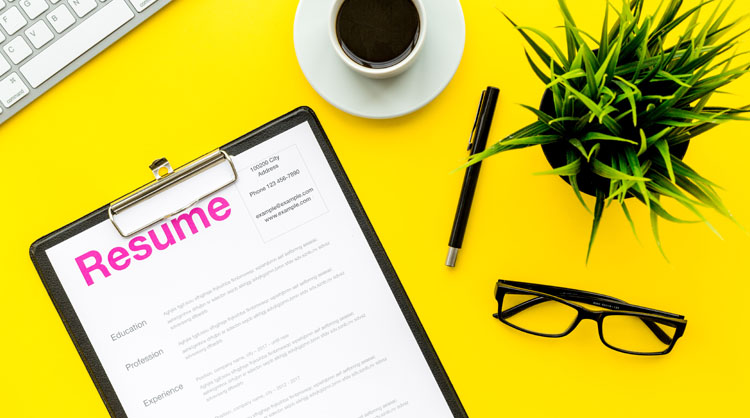How to hire the right person in 4 simple steps

Aiming to hire the right person is always a challenge. One of the biggest hurdles that employers face when growing their business is hiring the right people and building a team of professionals who are committed to the company’s vision. Every employee has a direct effect on your business, which is why finding the right person is well worth the effort.
To grow your business, you’ll need to consider your hiring process and how you can develop it so that you can attract (and keep) the very best talent. Read on for the top employee recruitment tips that will help you hire the right person for the job:
Ways to ensure you always hire the right person
- Have objectives in place.
- Look beyond the resume.
- Ask the right questions.
- Get a second (or even third) perspective.
1. Have objectives in place.

When it comes to recruiting new people, if you know what you’re looking for you’re more likely to make the right decision. Some hiring managers might be tempted to “wing it” by going with the flow, but this approach can lack direction and focus. Before you even begin interviewing candidates, it’s important to set your objectives. Once you do that it will be easier to formulate the right questions to ask during the interview.
Firstly, work out what you need from the position; i.e. what the person is expected to do and what skills they need to perform their role, and then establish performance expectations. With this information, you’ll be in a better position to evaluate the candidates and find the right person for the role.
2. Look beyond the resume.

While resumes are a great way to get an overview of a person’s skills and experience they often don’t give away the whole picture. Sometimes you’ll find a better hire is the individual who is enthusiastic and willing to learn the ropes, rather than the one with a glowing resume and years of experience.
In addition, workers are more likely to stay in a role if it offers adequate challenges and the chance for career progression. According to a report on workforce trends Australia’s average employment tenure is three years and four months, with many employees hoping to upskill quickly and increase their earning potential. If you want to hire someone who’ll stick around, you may consider a candidate who perhaps doesn’t have all the skills you’re seeking, so that they have the opportunity to grow and develop these skills.
3. Ask the right questions.

Once you have identified your objectives, it’s time to pre-select the interview questions to find out whether your candidates have the right skills and personality for the role.
A good interview should be made up of several types of questions: icebreakers, common interview questions, situational questions, behavioural questions and cultural-fit questions. These will create a more well-rounded view of the candidate and allow you to learn about who they are and what they will bring to your team. Let’s go through some examples:
Icebreakers
A quick icebreaker can help put candidates at ease before the interview and are a great way to build rapport.Here are a few examples:
- How has your day been so far?
- Were you able to find the office okay?
- Can I get you a glass of water?
Common questions
Common interview questions are ones that your candidate has likely prepared for, such as their strengths and weaknesses, their experience and other general topics related to their resume.Here are a few examples of common questions to ask during an interview:
- What would you say is one of your main strengths?
- I can see that you’ve had some experience with [skill, tool, program etc], can you tell me a bit more about it?
- Tell me about yourself
Situational questions
Situational questions are a great way to learn about how a candidate responds to different scenarios and their thought process.Here are some examples:
- What would you do if you were faced with an angry customer?
- How do you handle quick deadlines/busy periods/ stress?
- What would you do if a customer asked you a question that you did not know the answer to?
Behavioural questions
After the situational questions, you can lead in with a couple of behavioural questions. These questions require the candidate to discuss a specific example from their experience and how they handled it.Let’s go through a few examples:
- Tell me about a time when you had to take on multiple projects. How did you manage your time?
- Tell me about a mistake you made and what you learned from it. How would you do things differently in the future?
- Talk me through a time when you had to delegate work to your team members, how did you go about it?
Cultural fit questions
And finally, cultural fit questions can help you determine whether the candidate will be a good fit for the team and the unique environment of your organisation. For some employees, cultural fit is one of the most important factors when determining a candidate’s success.Here are some examples:
- Describe your ideal work environment
- Why do you want to work for us?
- How would your former colleagues describe you?
- What is the most important thing you want from your team/boss?
4. Get a second (or even third) perspective.

If you’re in a position where you urgently need to fill a role, you might be tempted to avoid the perceived bureaucracy of multiple interviews. However, the expenses of recruiting a new employee can range between 50-66% of the employee’s yearly salary according to estimates from Workplace Info. Therefore, taking your time with the hiring process may prove to be the more cost-effective option.
It is also difficult to completely eliminate individual biases when hiring a new employee, which is why it is important to involve other perspectives to make the hiring process as fair as possible. You can either conduct a panel interview with two or more people (team members or HR personnel) or have two or three interview stages where the candidate can meet some of the other people on the team.
At the end of the day, your company’s success relies on the individuals who are part of it. By setting your objectives, preparing solid interview questions and having multiple perspectives throughout the hiring process you have a much greater chance of hiring the right person for your business.
Could you work in Human Resources?
Working in HR means that you'll be at the forefront of an organisation, dealing with everyone from upper management to day-to-day staffers. Hone your people-skills, learn about legislation, discover safe workplace practices and enter one of the most rewarding career sectors in Australia. Search Human Resources courses here.


)
)

